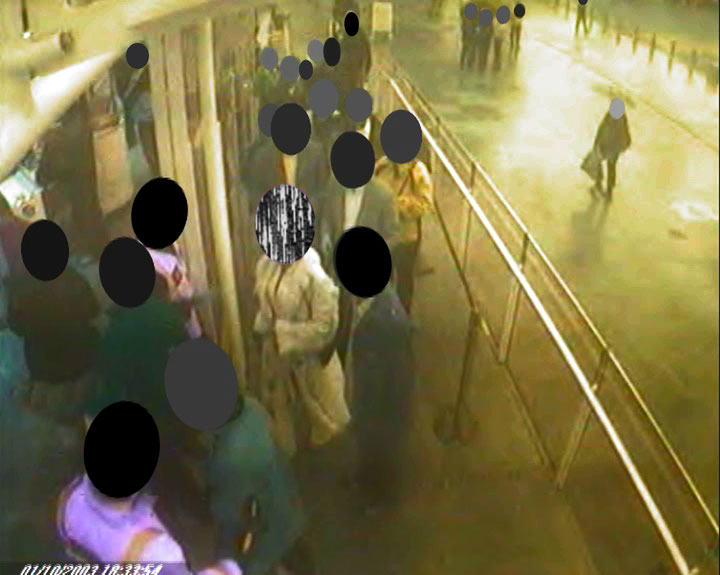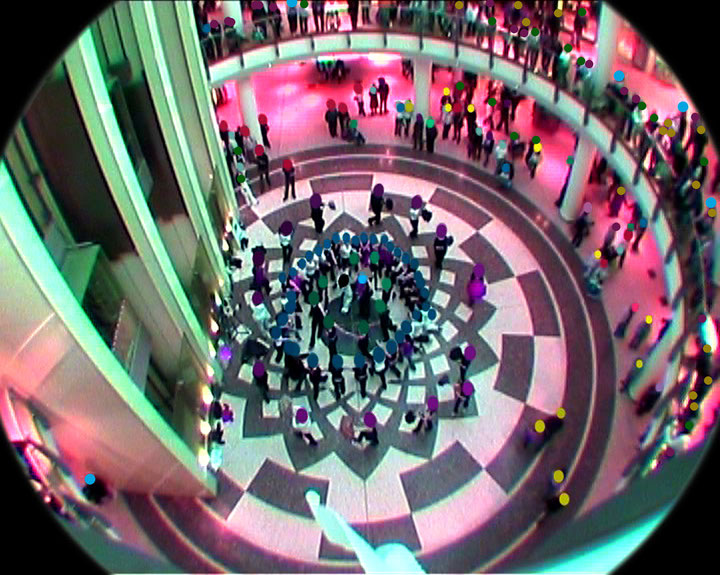Issue 4/2008 - Net section
Within the apparatus of control
On the enduring fascination of surveillance aesthetics
The network of video surveillance devices has been growing denser and denser – and not just since 11th September 2001 – prompted by the phantasm of a serious emergency, which might occur at any moment. Estimates put the number of Closed Circuit Television cameras (CCTV) in England, a frontrunner in technical observation, at over four million already. It seems fair to say that voyeuristic screen users’ need to exercise control is – to some extent – satisfied by the public availability of some of the images from these cameras. On Shoreditch TV some Londoners can already access footage from surveillance cameras showing the immediate vicinity of their homes. These kinds of development feed into the slogans promoting new structured security measures at grassroots level, such as those introduced by Texan Governor Rick Perry for his »Virtual Border Watch Program« to monitor migratory flows from Mexico via Internet 2.0. However, the July 2005 attacks on the London Underground demonstrate that even a seamless network of surveillance cameras does not prevent terrorist attacks. Instead it is likely that »sitting at your post« in front of the screen is likely to gain ground as a new leisure activity, which awakens memories of the quotidian snooping prevalent in the GDR.
This kind of observation was the starting point for London-based Austrian media artist and filmmaker Manu Luksch to develop the idea for her feature film, »Faceless«, which has by now enjoyed broad critical reception, and which she produced on the basis of real surveillance footage. She uses solely footage from CCTV cameras as a ready-made scenario for the sequences of actions played out in front of the cameras installed in public settings to create the foundation for a poetic narrative on the disappearance of history and identity in the panoptic era of total control. In compliance with legal provisions in England, which accords the individuals depicted the rights to film material showing them, Luksch laboriously acquired the rights to the recordings from the operators of the surveillance apparatus. She docks into a specific media aesthetic with the sci-fi narrative based on this »surveillance footage«, its mode of production also addressed in a manifesto for »CCTV Filmmakers«; this aesthetic stems from the spatial apparatus of technical surveillance via the eye of the camera and in addition is also constituted by the pictorial quality of sometimes elderly recording systems in London.
Mostly the distinctive features of the surveillance aesthetic are reminiscent of early forms of video art. The images seem to stem from the past future, from the once visionary buzz-laden era of the early days of the new media, long superseded by cool server technocracy. Whilst the equipment deployed in public control is currently shrinking to the miniature format of high resolution Webcams, and super-zoom cameras with extreme noise compensation and maximum contrast values have reached the mass market, the visual grammar of the surveillance aesthetic in artistic production is constructed upon a machine-produced image characterised by out-of-focus images and technical problems. A constantly flickering image, colour distortion and fragmented sequences, complete with a visible time-code, are all significant elements in this semantic code. In contrast, where newer digital methods of transmission and recording – such as by Webcam – are explicitly utilised, the key elements defining the pictorial language are the blurry tracks that movements leave due to delays in data transfer or indeed changes in slow-mo dynamics.
This leads to a remarkable shift in forms of representation: on the one hand, the capacity for representation increasingly approximates to a precision very close to that found in reality. Since early 2008, for example Google Street View’s camera vehicles have been making their way around German cities, in order to photograph all the streets with high-pixel precision via a system made up of lenses organised in a circle around a periscope. The purpose of all this is to enable time-compressed online strolls from one’s computer at home. On the other hand, in artistic productions or the popular culture of films, the aesthetic of surveillance draws its vocabulary from distancing effects, which reference the limitations of recording technology that has long become technologically obsolete. The intended identification of seemingly documentary images with situations of control or oversight does not seem to be produced until the aesthetic differentiation distinguishing these pieces from trivial depictions of the quotidian comes into play; as a result, the drama inherent to these images is communicated in keeping with the principle that »form follows data«.
It is in the very nature of these pictorial motifs from the feedback loop of the real-time world to focus attention on the permanent observation of neuralgic nodes in urban spaces, all of which are imbued with the stigma of risk. These motifs also structure, for example, the visual course adopted by Manu Luksch’s film »Faceless«. Attention is focused just as much on bustling areas, like underground stations or shopping malls, as on lonely car parks, underground garages or the parched periphery of housing estates, not to mention office premises or lobbies.
[b]The aesthetics of surveillance in contemporary art[/b]
Based on these strategies of visual transposition, one could write a pictorial history of the aesthetics of surveillance in the area where contemporary art, new media culture and film overlap. This history could pick up on analyses of the info aesthetic developed by Lev Manovich1 and refer to works by Bruce Nauman, such as »Video Surveillance Piece (Public Room, Private Room)« from 1969–1970, in which Nauman enables the audience in the art space to adopt the perspective of the gaze exercising control via the camera.
As paradigms of this approach, one might cite Harun Farocki’s documentations of war and surveillance as phenomena of post-industrial society, as in the film »Ausweg« (1994) on the economic dynamics of armaments production or Farocki’s interior view of the maximum security prison in Corcoran, California, from 2000. In contrast, media artist and theoretician Jordan Crandall focuses on conflicts between people and direct human violence in his installations, for example in »under fire« (2004).
Particularly in Crandall’s oeuvre, but also in works by artists like the New York activist group Surveillance Camera Players with Michael Carter and Bill Brown, who intervene as performers in front of public cameras and thus produce short films as media partisans, it becomes apparent that under the conditions shaped by the whole surveillance apparatus there is a correlation between the aesthetic media apparatus and a typical spatial configuration. This becomes clear from the positioning of the camera, which is mostly static and films from above at an oblique angle. In this coordinate system of monitoring, we find an acute expression of what Henri Lefebvre analysed as a fundamental social implication in pointing out that every space perceived must always be read as the result of social production.2 The recurring ideograms of spatial situations function as codes, which enable immediate identification of the substance of the overall context within the aesthetic of surveillance.
[b]Observing scenarios of potential danger[/b]
Even in the short form of video clips – such as for example in Fabri Fibra’s politically critical MTV video »In Italia«, in conjunction with Gianna Nannini – a few seconds of footage suffice to construct the intended framing. The codes of surveillance images have begun to assume a self-evident place in our perceptual repertoire, although here the suggested real urban space of this semiotic system appears as a traffic and communication network of wiring diagrams. Friedrich Kittler sees the thoroughgoing interconnection of these elements in the context of the parallel genesis of media and warfare technology.3 That is the basis for the geopolitical aspect of an increasingly dense network of military occupation of urban terrain by the omnipresent eye of never-tiring machines. The psychological thrill of looking through the surveillance unit stems not so much from the voyeuristic structure of observation but much more from participating indirectly in a potentially dangerous scenario. That may also explain the fascination of British television programmes with surveillance images, which function in the same way as weather channels elsewhere. What is dished up is ambient TV with disposable images, where the audience can explore movable targets from the safe position of invisibility.
In contrast, the political dimension of Manu Luksch’s film »Faceless« lies primarily in its reference to the tendency towards total recording of everyday life through CCTV images and to efforts to appropriate images showing one’s own face using existing legislation. In England other people’s faces must be deleted from such footage for legal reasons, rendering them »faceless«. The pictorial universe is based on genuine surveillance scenarios. However, through reflections on regaining identity, never pinned down and pronounced by an authorial narrative voice – a part spoken by Tilda Swinton – the production rises above the monotonous logic of control and opens up questions about the altered topographic conditions of perception in the panoptic age when observation is omnipresent.
Translated by Helen Ferguson
1 C.f. Lev Manovich, Modern surveillance machines: Perspective, radar, 3-d computer graphics, and computer vision, in: T. Y. Levin, U. Frohne & P. Weibel (eds.), Ctrl[space]. Rhetorics of Surveillance from Bentham to Big Brother. Cambridge, Mass. 2002.
2 Henri Lefebvre, Die Produktion des Raumes, in: J. Dünne & S. Günzel (Hg.), Raumtheorie. Frankfurt am Main 2006, pp. 330–342 (Orig. »Dessin de l’ouvrage«, in: H. Lefebvre, La production de l’espace. Paris 2000 (1974), pp. 7–82).
3 C.f. Friedrich Kittler, Die Stadt ist ein Medium, in: G. Fuchs, B. Moltmann & W. Prigge (eds.), Mythos Metropole. Frankfurt am Main 1995, pp. 228–244.



